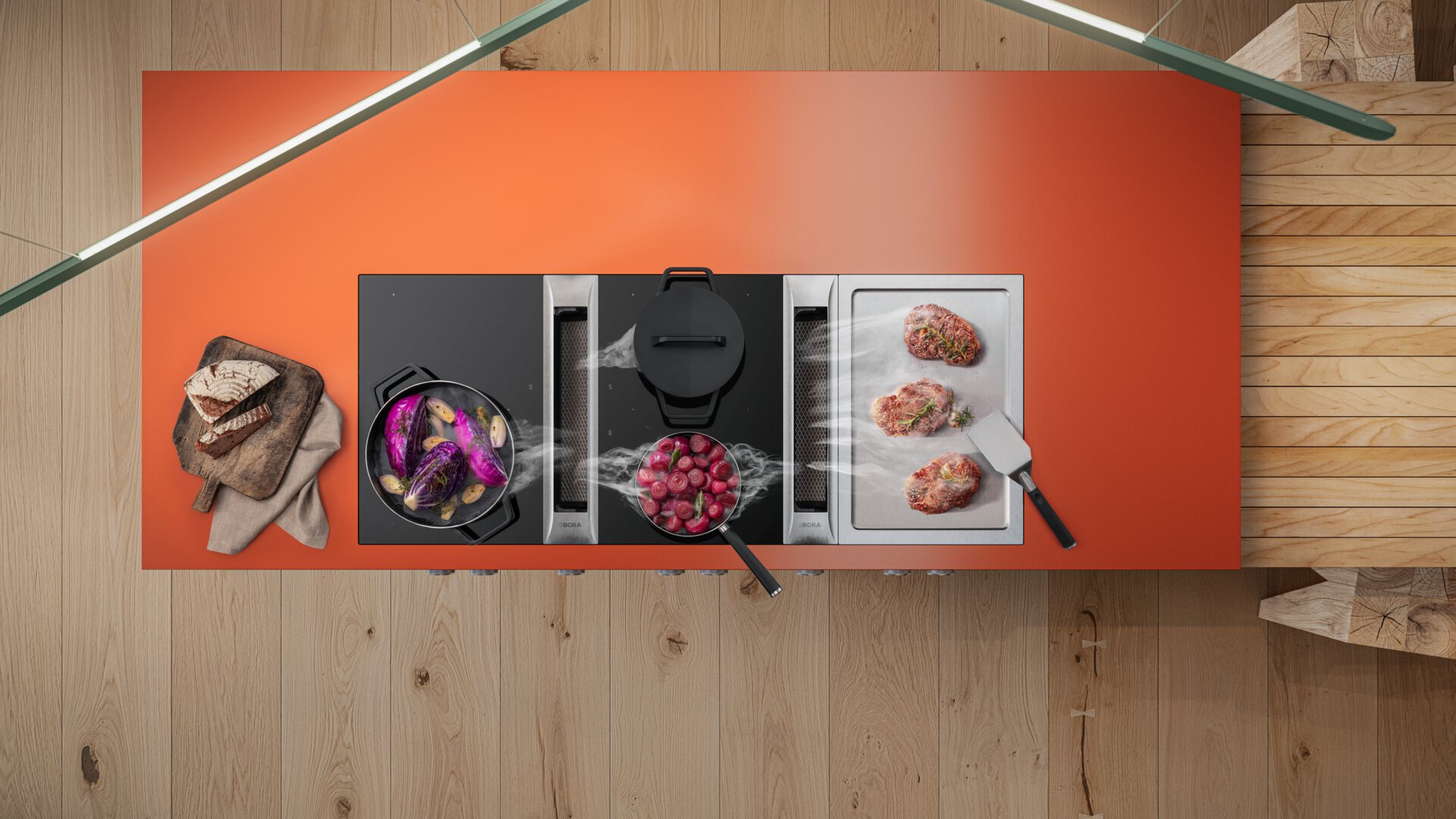

The cooktop is the heart of every kitchen. It’s where delicious dishes come to life. There are different kinds of cooktops in a range of sizes and materials and with varying features. At BORA, both novices and seasoned amateur chefs will find the right cooktop.

Induction cooktops have flat round coils that create an electromagnetic field when the cooktop is switched on. So that this can generate heat at the base of the cookware, the cookware must have a magnetic base; this is the only way that the energy from the magnetic field can be absorbed as heat. This applies, for instance, to pots and frying pans made of stainless steel, cast iron and enamelled iron.
When cooking on an induction hob, the risk of burns is relatively low as the heat generated is concentrated at the base of the cookware. The surrounding area of the cooktop is heated significantly less, merely from the heat recovered from the cookware. Thanks to the power setting on the induction cooktop, the heat-up time is very short. What’s more, accurate temperature adjustment is also possible.
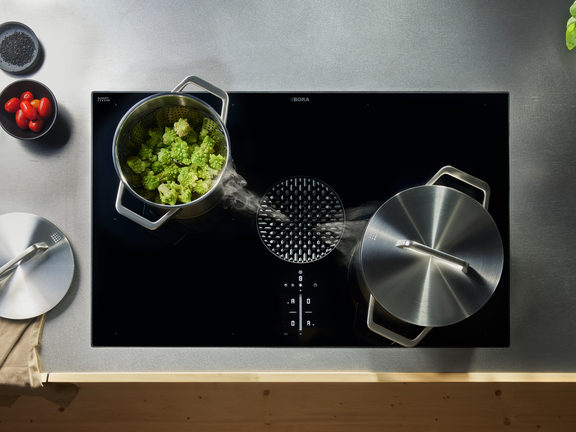
On surface induction cooktops, square coils made of wound wire also generate an electromagnetic field. With the help of the bridging function, the square shape of the coils means that a very large cooking area can be created. In turn, more or bigger cooking pots can be placed on the cooktop. It even enables large roasters to be used on the cooktop. Thanks to the automatic pan size recognition function, only the coil is activated above which induction-compatible cookware has been placed. This means that only the necessary cooking zone is in use.
As well as this flexibility when cooking, surface induction cooktops also have the advantage of having an attractive, very elegant design, as only very discreet cooking zone markings divide up its surface.
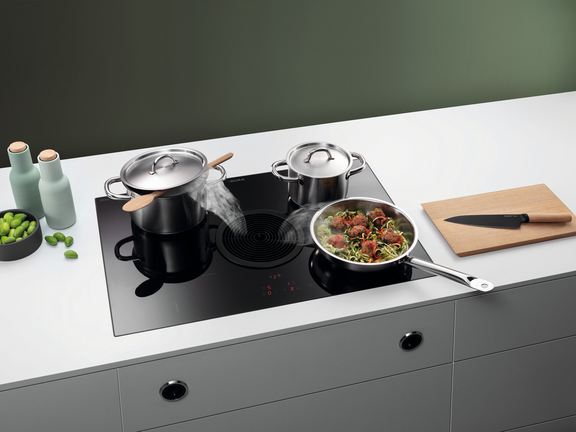
A cooktop with a radiant heating element is none other than what is commonly referred to in Germany as a Ceran cooktop. However, strictly speaking, this term is incorrect. ‘Ceran cooktop’ simply refers to a glass ceramic cooktop. Ceran is a brand name of the company Schott AG, a manufacturer of high-quality glass ceramic, and so it is frequently used as a synonym.
In the case of radiant heating elements, heating coils are located under the glass ceramic plate of the electric cooktop. On these cooktops, energy is transferred by heat radiation. Contrary to induction cooktops, radiant heating elements do not have an automatic pan size recognition function, meaning that any cooking zones that are switched on will become hot even if there is no cookware on them.
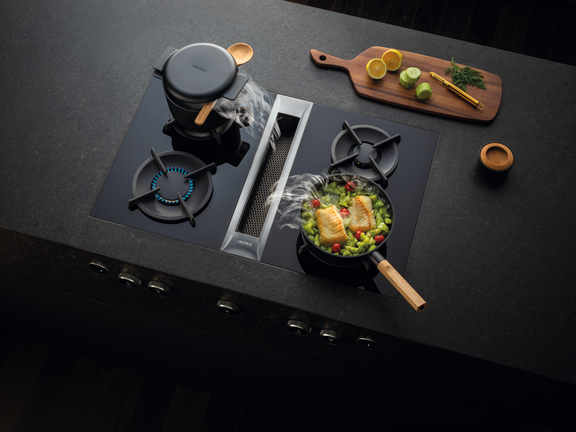
Gas cooktops are especially popular among professional chefs. For most it is also a question of philosophy. They swear by cooking with gas: the heat is generated by a seamlessly adjustable flame. This means that a gas cooktop quickly and accurately brings pots and frying pans up to temperature. Just as the flame appears instantaneously, it disappears as soon as the cooktop is switched off. Food does not continue to cook and nothing burns. Modern gas cooktops are incorporated in a glass ceramic cooktop and barely have anything in common with the old-fashioned-looking gas cookers of the past.

Tepan, teppan-yaki or teppanyaki – there are a number of ways to write this cooktop’s name. Nonetheless, it always refers to a smooth steel plate on which you can grill food. The Tepan cooktop was inspired by the Japanese art of grilling. As in traditional Japanese cuisine, the chef places fish, meat or even vegetables directly on the teppanyaki griddle built into the cooktop.
A stainless steel teppanyaki grill usually has two cooking zones that can be set separately. This enables you to sear a steak on one side, whilst vegetables are slowly cooking on the other. A Tepan stainless steel grill is available in the BORA Professional and BORA Classic cooktop ranges.
FYI: there’s no need to worry about food burning! Tepan cooktops are easy to clean. All you need is water, vinegar, kitchen roll and our Tepan spatula. Our guide tells you how to clean a teppanyaki grill step by step.
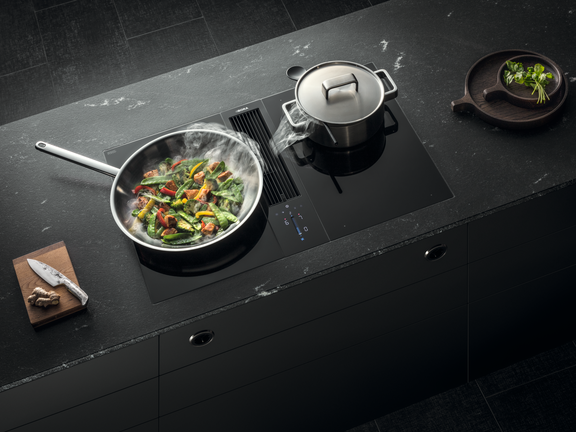
Asian cuisine gives us another utensil that enables us to cook tasty, healthy meals: the wok. For the Professional and Classic lines, BORA offers a glass ceramic cooktop with a built-in induction wok. The matching ferromagnetic wok fits perfectly inside the hollow in the cooktop. This enables the magnetic field under the glass ceramic to heat food extremely quickly and accurately. Another advantage compared to cooking in a wok on a flat electric or induction cooktop is the higher energy efficiency.
We generally differentiate between stand-alone cooktops and cooker hobs. A stand-alone cooktop has its own operating elements and can be placed just about anywhere in the kitchen.
In contrast, a cooker with a hob and oven below it provides kitchen planners with less design freedom. BORA cooktops are generally stand-alone appliances. This allows you to enjoy a great deal of freedom when planning your kitchen.
Do you like to cook most dishes on a gas hob, but others on an induction hob? With BORA, you don’t need to choose between them. In the BORA Professional and BORA Classic lines, gas and induction can be combined in a single cooktop. Do you like experimenting in the kitchen and have a passion for Asian cuisine? How about an induction cooktop combined with a teppanyaki grill – the stainless steel grill from Japan – or a wok cooktop? BORA offers you a range of options for your cooktop.
Are you planning a new kitchen or would like to renovate your existing one? Depending on how much available space you have in the kitchen, cooktops of different sizes and dimensions come into consideration. At BORA, you can get cooktops in the following sizes:
| Product | Heat type | Dimension (width × depth) |
|---|---|---|
| BORA Professional 3.0 *1 | Induction | 370 mm x 540 mm |
Surface induction | 370 mm x 540 mm | |
Radiant body | 370 mm x 540 mm | |
Gas | 370 mm x 540 mm | |
Induction wok | 370 mm x 540 mm | |
Tepan | 370 mm x 540 mm | |
| BORA Classic 2.0 *2 | Induction | 375 mm x 515 mm |
Surface induction | 327 mm x 515 mm | |
Radiant body | 327 mm x 515 mm | |
Gas | 327 mm x 515 mm | |
Induction wok | 327 mm x 515 mm | |
Tepan | 327 mm x 515 mm | |
| BORA X Pure | Induction, surface induction | 830 mm x 515 mm |
| BORA M Pure | Induction, surface induction | 760 mm x 515 mm |
| BORA Pure | Induction | 760 mm x 515 mm |
| BORA S Pure | Induction, surface induction | 580 mm x 515 mm |
| BORA Basic | Radiant body | 760 mm x 515 mm |
*1: information on dimensions refers to the cooktop without a cooktop extractor
*2: information on dimensions refers to the cooktop without a cooktop extractor
There are various types of cooktops: gas, induction, glass ceramic and electric cooktops.
Induction is generally hotter and quicker than gas as the heat is generated in the base of the pot. Induction cooktops can reach temperatures of up to 240–300 °C, depending on the setting and cookware. Gas cooktops can reach temperatures of up to 200–250 °C, depending on the intensity of the flame and the burner type.
For induction hobs, you need pots with a magnetic base, like stainless steel or cast iron. Aluminium and copper pots will only work if they have a ferromagnetic base.
Ceran is a brand name for glass ceramic. Both terms refer to the same material and technology.